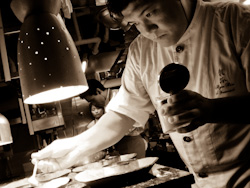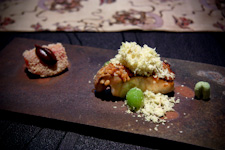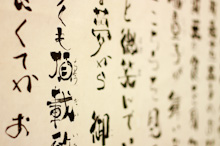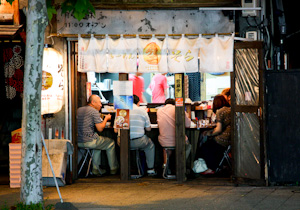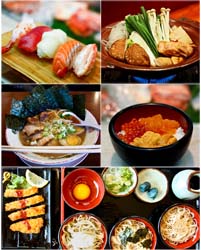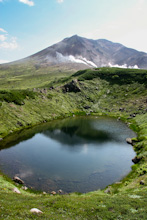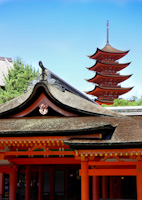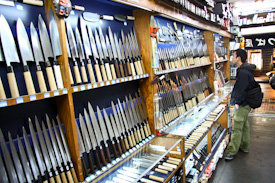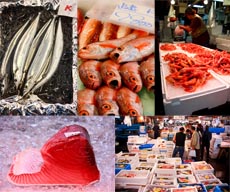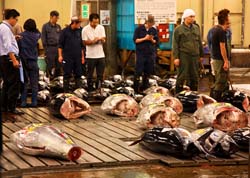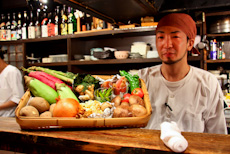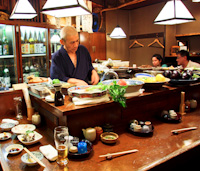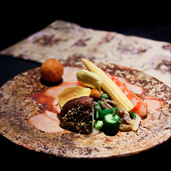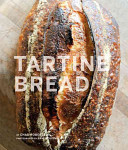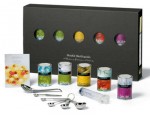Nihonryori RyuGin - Working and eating
Prologue: It’s August, Japan’s hottest and most humid period of the year. After a nice trip, eating my way through Japan, from north to south, I’m getting ready to go to work. I managed to get an apprenticeship in one of Tokyo’s most reputable restaurants - the two Michelin star Nihonryori RyuGin belonging to the chef Seiji Yamamoto. The restaurant is located on a back street of Tokyo’s bustling Roppongi district, a neighbourhood teeming with bars, clubs, eateries, entertainment and foreigners.

Seiji Yamamoto - The man who made a name for himself outside of Japan by sending a Hamo eel to a CT scan to better understand its anatomy and the best way to cut it according to its bone structure.
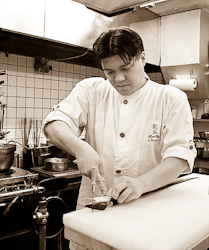 Yamamoto-san has been classically trained and is in many ways true to traditional Japanese cusine but has also become famous for combining tradition with groundbreaking space-age technique. He has an unlimited passion for food, is strikingly creative and is constantly thinking about the kitchen, kitchen, kitchen and the spirit within it.
Yamamoto-san has been classically trained and is in many ways true to traditional Japanese cusine but has also become famous for combining tradition with groundbreaking space-age technique. He has an unlimited passion for food, is strikingly creative and is constantly thinking about the kitchen, kitchen, kitchen and the spirit within it.
Before coming to the restaurant I had seen a Tv documentary starring him and his Tokyo collegue Toru Okuda, showing viewers their never-ending hard work, their approach to cooking and the quest for fame.
Yamamoto-san is just as calm, pensive and thoughtful as the documentary had depicted, although on certain occasions he can get really enthusiastic and sparkling, especially when talking about a special ingredient in peak season or about the best way of cutting a vegetable for perfect texture.
I felt it was hard to know what to expect from a restaurant kitchen on such a distinguished level, two Michelin stars do create a fair bit of expectations, and even more so from a restaurant on that level, in Japan!
What I found when I got there was eight cooks working in a tight space, a seemingly normal restaurant kitchen with simmering stocks, humming refrigerators and rich perfumes of aromatic herbs.
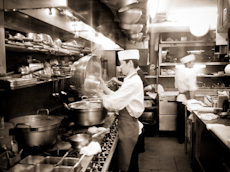 I have never seen such perfect produce anywhere, all vegetables, fruits and herbs being of flawless appearance, identical shape and bursting with juices and flavor! But of course this comes at a price. Apples and peaches are sold, not by weight but a piece, at prices that are sometimes incomprehensible. One single apple can easily cost as much as one kilo of apples would cost in Europe. Another fruit that is strikingly expensive are grapes, where prices for one single bunch can start at 8 euros (around $11 US).
I have never seen such perfect produce anywhere, all vegetables, fruits and herbs being of flawless appearance, identical shape and bursting with juices and flavor! But of course this comes at a price. Apples and peaches are sold, not by weight but a piece, at prices that are sometimes incomprehensible. One single apple can easily cost as much as one kilo of apples would cost in Europe. Another fruit that is strikingly expensive are grapes, where prices for one single bunch can start at 8 euros (around $11 US).
Much the same goes for the rest of the fruit and vegetables, and even for meat and fish.
Back in the kitchen - It’s actually no wonder that their fish and seafood are fresh considering that there are aquariums with live fish in the kitchen and the prawns are delivered live in water with an battery-powered aquarium pump.
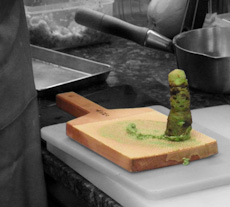 On my first starting day I was thrown straight into the core of the kitchen - I was in charge of the special shark skin Wasabi grater! The wasabi root must be extremely fresh and is grated in small amounts for every order to not loose its pungency and fragrance.
On my first starting day I was thrown straight into the core of the kitchen - I was in charge of the special shark skin Wasabi grater! The wasabi root must be extremely fresh and is grated in small amounts for every order to not loose its pungency and fragrance.
Day two I started studying the making of Dashi, the building brick of the whole Japanese cuisine. Dashi is a clear stock made from two base ingredients, “kombu” (kelp seaweed) and shavings of “katsuobushi” (dried bonito tuna). Dashi is a very sublime mixture tasting only mildly and deliciously of the sea. Its lack of overpowering flavors makes it very versatile and it’s used as a base for the famous Miso soup, for marinating, for braising, as a soup stock, simmering liquid or as part of a sauce or a dressing.
Seiji Yamamoto uses very little salt, next to none, in comparison to many other chefs. Instead he has his ways of marinating everything, in broth, in dashi, in soy sauce, in aromatic pastes. And he uses his own special techniques for rendering meat and fish unforgettable.
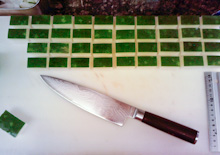 On the third day I was allowed to start using a knife, and take part in the real preparations of meat and vegetables.
On the third day I was allowed to start using a knife, and take part in the real preparations of meat and vegetables.
Japanese chefs don’t really use a lot of different knives, they are taught to do their work with just a few knives at hand. And it’s truly intriguing to see how they use their razor sharp vegetable knife, “Usuba” in Japanese, for so many different tasks, from peeling to cutting, to cubing, to needle-cutting, to chopping, to carving, to shaving.
During my time at RyuGin, I saw my chef de partie, Hieda-san, using only 2 knives, with a third one thrown in on the odd occasion. Now this is during work for which I myself would use a peeler knife, a pairing knife, a chopper, a carver, a slicer, a filleter, a boning knife, a chef’s knife, a bread knife AND my Swiss Army knife.
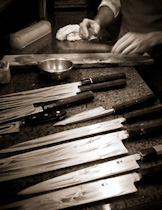
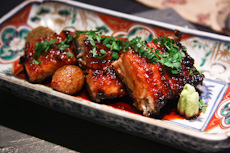 One of RyuGin’s signature dishes is the charcoal-grilled wild eel - large and meaty eel with exceptionally crispy skin, lacquered with a secret recipe soy sauce glaze.
One of RyuGin’s signature dishes is the charcoal-grilled wild eel - large and meaty eel with exceptionally crispy skin, lacquered with a secret recipe soy sauce glaze.The charcoal grill has such an important status in Japan. Where we Westerners much more often rely on a red hot skillet to give meat and fish its exquisite maillard reaction, the Japanese turn to the charcoal grill fed with their special non-smoking, long-burning hard charcoal called Bincho-tan. Almost anything can be skewered and placed on the grill it seems!
Japan is a food-crazy nation like few others and this reflects in many aspects of society. On television, in the sheer amount of restaurants around, in the variety of food offered, the advertising, and their willingness to eat stuff that no sane Westerner would even think about putting in their mouth.
What I found comforting with eating in Japan, was that most of the food is not mixed to the point of indistinguishability, drenched in sauce, hidden in a stew - presentation is extremely important and therefore many ingredients are often presented on their own or arranged on the same plate but with clear separation between the different components. As another important part of the presentation enters also the plates and bowls used for serving the food.
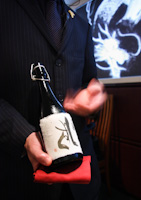 A funny and interesting thing about Japanese restaurants, especially in cities such as Tokyo, is how often they are specialized in one type of cuisine, no - one type of food. And then they concentrate all their time and effort in becoming experts on making that particular thing. Where I come from people get pissed off when they read the menu and understand that they can not have sushi as an appetizer, followed by a pasta Bolognese, then a barbecued beef brisket with a side of curry rice and some french patisserie with a Jamaican coffee to finish on a good note…
A funny and interesting thing about Japanese restaurants, especially in cities such as Tokyo, is how often they are specialized in one type of cuisine, no - one type of food. And then they concentrate all their time and effort in becoming experts on making that particular thing. Where I come from people get pissed off when they read the menu and understand that they can not have sushi as an appetizer, followed by a pasta Bolognese, then a barbecued beef brisket with a side of curry rice and some french patisserie with a Jamaican coffee to finish on a good note…
In Japan a restaurant with a limited menu say, serving only food from the sea in different ways, or only chicken or even only eel - is not a problem. On the contrary, it should give you some sort of notion that they are experts within their field.
Then there are also some restaurants, among them RyuGin, that serve a cuisine “Kaiseki” style which incorporates many different features of the Japanese cuisine, what one could describe as a kind of “best of the best” cooking.
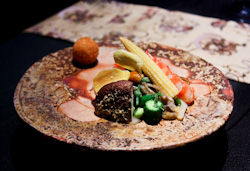 Entering the dining room, you immediately notice the one wall that is dominated by a large black-and-white ink painting of a dragon, the ever-present house mascot. The dining room is artistically decorated, with an unsubtle emphasis on dragons, but toned-down in a Japanese way and gives definitely a classy atmosphere.
Entering the dining room, you immediately notice the one wall that is dominated by a large black-and-white ink painting of a dragon, the ever-present house mascot. The dining room is artistically decorated, with an unsubtle emphasis on dragons, but toned-down in a Japanese way and gives definitely a classy atmosphere.
The staff is amazing, hard-working and with a total focus on service. The dining room team is lead by the extremely polite and knowledgable restaurant manager Arimasa-san. During my dinner in the restaurant, the staff was attentive and ever-present, but incredibly smooth, in a ninja kind of way, and never intrusive.
The meal I had in the restaurant was definitely one of the most memorable meals I have had so far. Not having known Japanese fine-dining cuisine to any significant depth before, this was a revelation.
There is a substantial difference in feeling between, on the one hand working and preparing the food in the kitchen and, on the other hand, sitting down and enjoying the same food in the dining room atmosphere.
